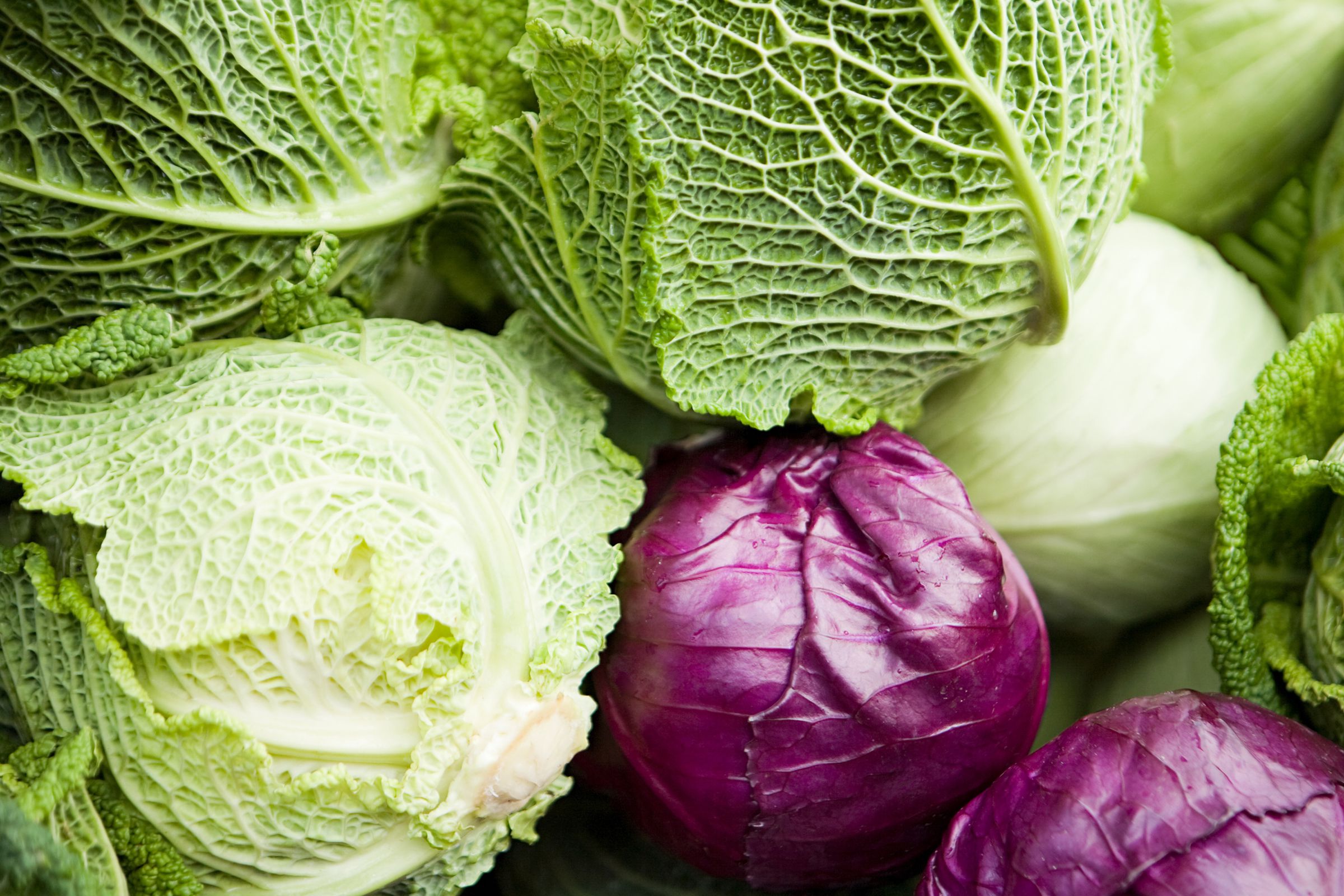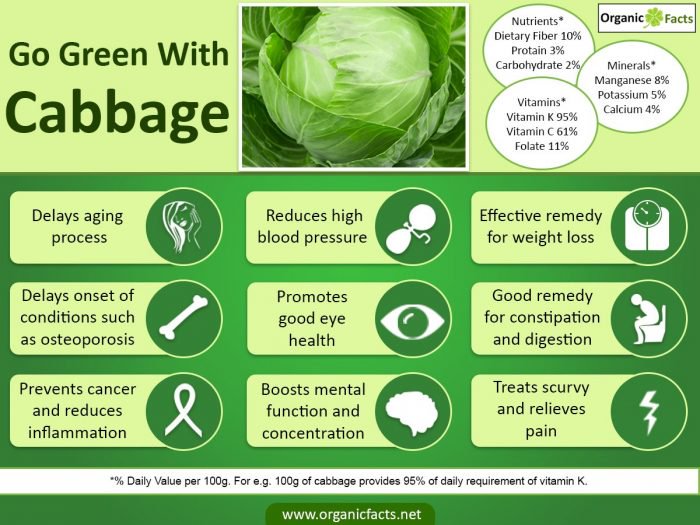Cabbage: 11 Varieties and 20 Health Benefits

Did you know that you don’t need to purchase organic cabbage to avoid pesticides? EWG reports that only two of more than 700 cabbage samples contained more than one pesticide residue. 86 percent of cabbage samples contained no detectable pesticide residue. Stock up on this hearty leafy green and all its health benefits.
The health benefits of cabbage include its frequent use as a treatment for constipation, stomach ulcers, headaches, obesity, skin disorders, eczema, jaundice, scurvy, rheumatism, arthritis, gout, eye disorders, heart diseases, and Alzheimer’s disease.
What is Cabbage?
Cabbage is a leafy green, red, or white biennial vegetable which is grown annually. This cruciferous vegetable belongs to the Brassica family and is round or oval in shape. It consists of soft, light green or whitish inner leaves covered with harder and dark green outer leaves. It is widely used throughout the world and can be prepared in a number of ways, but most commonly, it is included as either a cooked or raw part of many salads. Cabbage belongs the group of cole crops, which means that it is closely related to broccoli, cauliflower, and Brussels sprouts.
Here are 11 varieties of cabbages and their uses
1. Cannonball Cabbage
This is a small, green cabbage variety that is sometimes described as a mammoth Brussels sprout, and them most common variety found at grocery stores and markets. They only grow to be about 12 inches across (which still makes for a lot of delicious greenery) with very dense leaves, making it perfect for shredding into coleslaw or sauerkraut.
2. Bok Choy
Bok choy is in fact a type of cabbage, but develops thick, white and watery-crisp stems and leaves that are green and tender. More akin to Swiss chard or spinach than a regular head of cabbage, bok choy makes an excellent addition to sautéed vegetable sides, stir-fries and Asian inspired soups.
3. Choy Sum
Sometimes labeled as ‘Chinese Cabbage’ choy sum can be found at mot grocery stores and all Asian food markets. This cabbage looks similar to bok choy, but is slightly slimmer and longer, with crispier stems and very tender leaves. It’s great chopped into an Asian salad with oranges and peanuts.
4. Early Jersey Wakefield Cabbage
This cabbage variety originates from Yorkshire in the U.K., but has morphed into a classic American heirloom over the centuries. The green cabbage has a heart or cone shaped head, which forms into a point that is surrounded by similar shape pale green leaves. These cabbages usually weigh 3-4 pounds and are excellent for plain steaming or light sautéing.
5. January King Cabbage
This curly-leafed cabbage displays gorgeous blue-green leaves with brushes of purple and dapples of turquoise. As the name implies, this cabbage variety enjoy cool weather and can even be planted in the fall for winter harvests. Rather small at 1 pound a head, this showy cabbage is great roasted and served as a unique side dish.
6. Napa Cabbage
Oblong in shape with crisp stems and frilly, greenish yellow leaves, this cabbage variety is sweet and softer than the average green cabbage. It is delicious raw in salads as a dumpling filler or steamed with other leafy greens and drizzled with lemon juice.
7. Portugal Cabbage
Another type of green cabbage, Portugal cabbage originates from the Mediterranean region. The plant features large, spread and ribbed leaves but forms no head; the rib part of the leaf and the top of the stem are the parts that are eaten. The leaves are tough but fantastic in a hearty Portuguese style soup!
8. Red Drumhead Cabbage
Red cabbages are typically tougher and deeper in flavor than green cabbages, and were traditionally harvested in the fall for pickling. Plant breeding has now allowed for more tender varieties of red cabbage that can be shredded into salads and coleslaws. Red cabbages are great options for veggie patches, as they tend to attract less worms and produce large, round heads.
9. Savoy Cabbage
The crinkly leaves of the beautiful savoy cabbage are deep green along the edges, turning yellow toward the base. The flavor of a savoy is earthy but mild, and smaller heads are perfect for grating or slicing into salads and stir-fries. Savoy cabbage is also a great choice for fermented foods like homemade kimchi!
10. Walking Stick Cabbage
This 2 to 3 foot tall variety looks more like kale than cabbage, the leaves of which can be steamed or lightly sautéed when young. Originally from Great Britain, the larger leaves of this cabbage were once used as wrappers for baking hearth breads. The cabbage received its name from the strength of the stem, which is often saved for use as a walking stick, plant stake or bean pole.
11. Winnigstadt Cabbage
German in origin, the Winnigstadt cabbage displays dark green, glossy leaves in a large and dense head with a small point. This cabbage requires ample growing space, with its outer leaves spreading up to 3 or 4 feet across, and unfortunately often attracts worms. Sweeter in flavor than most other cabbages, this variety is ideal for raw salads and coleslaw, but is also an excellent choice for sauerkraut.
Cabbage is a very good source of manganese, dietary fiber, calcium, magnesium, and potassium. It is also rich in various vitamins including vitamin C, B6, A, K, and E. With a 100 gram serving of cabbage containing about 25 calories, it proudly takes the title of a healthy addition to your diet. It is also high in antioxidants including flavonoid, zeaxanthin, lutein, choline, and beta-carotene.
Health Benefits of Cabbage
Did you know that the inexpensive and widely used cabbage can practically work miracles? Let’s take the look at the best ones!
Antioxidant Agent
Cabbage acts as a good detoxifier too, meaning that it purifies the blood and removes toxins, primarily free radicals and uric acid which are the main causes of rheumatism, gout, arthritis, renal calculi, skin diseases, and eczema. This detoxifying effect of cabbage is due to the high content of vitamin C and sulfur in it.
Anti-inflammatory Agent
Cabbage is known to accumulate a build-up of cadmium-binding complexes in its leaves and one of the main components of that is glutamine. Glutamine is a strong anti-inflammatory agent, so consuming it can reduce the effects of many types of inflammation, irritation, allergies, joint pain, fever, and various skin disorders.
Supports the Body Against Cancer
One of the most celebrated health benefits of cabbage is its powerful antioxidant quality. This means that cabbage and other similar vegetables scavenge free radicals from the body, which can be detrimental to overall health and are major contributors to cancer and heart diseases.
It also contains another and glucosinolates that can be converted into isothiocyanate compounds that help in the prevention of various cancers including breast cancer, prostate cancer, bladder cancer, and colon cancer.
Red cabbage also has a number of anti-cancer compounds, like lupeol, sinigrin, and sulforaphane (glucosinolates derived isothiocyanate), which are known to stimulate enzyme activity and inhibit the growth of tumors that lead to cancer. One study, performed primarily on Chinese women, showed a significant reduction in breast cancer when cruciferous vegetables like cabbage were regularly added to their diet.

Cabbage is very rich in fiber and glucosinolates, which is the main health benefit of roughage. This helps the body retain water and it maintains the bulkiness of the food as it moves through the bowels. Thus, it is a good remedy for constipation and other problems related to digestion.
Roughage deficiency can be really fatal, but it is one that is commonly overlooked in the maintenance of personal health. A lack of roughage in food can result in constipation, which is the root cause of many other ailments and health hazards such as stomach ulcers, headaches, gastrointestinal cancers, indigestion, and a subsequent loss of appetite. The dangers of roughage deficiency even extend to skin diseases, eczema, premature aging, and hundreds of mild to serious conditions.
Regulates Heart Health & Cholesterol
By binding the bile acids, it helps to lower your total LDL cholesterol levels. Cabbage is also rich in polyphenols, which reduces the risk of cardiovascular diseases by reducing blood pressure and preventing platelet build-up.
Protects from Radiation Therapy
Cabbage has a rare compound called 3,3′-diindolylmethane (DIM), which has been shown to prevent the risks associated with radiation therapy. It helps in ensuring that the red and white blood cells and the platelet count remain existent, which is often not the case during radiation therapy. Therefore, DIM is also favored for use during cancer treatment in order to protect healthy tissue.
Boosts Immunity
Due to the high vitamin C content of cabbage, it helps in boosting the immune system and fighting off free radicals.
Skin Care & Vitamin C
As mentioned already, cabbage is rich in antioxidants, including vitamin C, anthocyanins, and sulfur, since it is a cruciferous vegetable. Antioxidants play a major role in skin health and the general toning and improvement of the body in response to the aging process. Free radicals can be an underlying cause of wrinkles, skin discoloration, spots, and many other conditions. Therefore, the antioxidants you get by eating cabbage can cause a turn-around in your aging processes, leaving you feeling and looking healthy and young. It also helps in preventing the onset of acne.
Weight Loss

Cabbage is frequently recommended for people who want to lose weight in a healthy way. Since cabbage is packed with many beneficial vitamins, minerals, and other nutrients, it is a healthy dietary option for people to eat and is quite filling since it has high levels of fiber, which add bulk to the bowels. It is also low in calories, amounting to only 33 calories in a cup of cooked cabbage.
Prevents Cataract
Cabbage is a rich source of beta-carotene, so many people, particularly as they get older, turn to cabbage for its ability to prevent macular degeneration and promote good eye health and delay cataract formation.
Hair Care
Cabbage being rich in sulfur and silicon helps in preventing dry hair. It also has a high vitamin A content that acts as an antioxidant and promotes hair health and hair growth.
May help to Prevent Prostate Cancer
Beta-carotene has been positively linked to reduced chances of prostate cancer, which is an extra bonus on top of other anti-carcinogenic effects of cabbage!
Improves Brain Health
Let’s not forget that cabbage is a very powerful brain food! The presence of vitamin K and anthocyanins within cabbage can give a strong boost to mental function and concentration. Vitamin K is essential for the production of sphingolipids, the myelin sheath around nerves. This wrapping is what protects nerves from damage and decay. Therefore, consuming vitamin K can improve your defense against neural degeneration, Parkinson’s and Alzheimer’s disease, and dementia.
Furthermore, the anthocyanins in cabbage are a current area of research, but early indications point to it being a more powerful source of antioxidants than vitamin C, and red cabbage has even more types of anthocyanins than normal cabbage. It also appears that the nutrient uptake is not limited by anything and that people can eat as much cabbage as they want, and continue to accumulate antioxidants, which help fight off diseases, reduce chances of cancer, improve the nervous system, and increase brain function.
Cabbage, being rich in iodine, also helps in the proper functioning of the brain and the nervous system, along with keeping the glands of the endocrine system in proper condition.
Improves Bones
Cabbage, as well as all cruciferous vegetables, are great sources of minerals, like calcium, magnesium, and potassium. These three essential minerals are integral in the protection of bones from degradation and the onset of conditions like osteoporosis and general bone weakening.
Regulates Blood Pressure
The presence of potassium in cabbage also makes it a wonderful way to protect yourself from elevated blood pressure, which increases the risk of heart attack and stroke. Potassium is a vasodilator, which means that it opens up the blood vessels and eases the flow of blood, so it isn’t being forced in a stress-inducing way through constricted arteries and veins. Overall, cabbage is a great shield against many types of dangerous conditions!
Reduces Muscle Aches
When certain bacteria ferment the sugars in cabbage during the preparation of sauerkraut, lactic acid is released. It isn’t the easiest compound to find in a diet, but it has been shown to reduce muscle soreness and aches, so in some small way, cabbage can help in general pain relief and muscle soreness, depending on how it is prepared.
Speeds-up Healing
Cabbage is rich in sulfur, which is a very useful nutrient as it fights infections. A deficiency of sulfur can result in microbial infections and a greatly reduced healing speed. It also reduces the frequency and severity of ulcers.
Other benefits
Cabbage can also be used for the treatment of varicose veins, leg ulcers, and peptic and duodenal ulcers.
Basically, this common component of your Chinese dishes could be a miraculous addition to your diet. Don’t be afraid to add cabbage to your daily diet, whether it is in your soup or salad, and that small change will help you live a healthier and longer life.
Uses of Cabbage
Cabbage can be used in various culinary uses and can be incorporated into our daily diet in the following ways:
- Salads: Cabbage can be shredded into salads with salt and other spices.
- Soups: It can also be boiled into a soup and served hot.
- Stews: It can be served raw or steamed into a stew with water and salt.
- Sauerkraut learn how to make your own
- http://cebp.aacrjournals.org/content/5/9/733.short
- http://www.sciencedirect.com/science/article/pii/S1043661807000321
- http://www.plantphysiol.org/content/76/3/797.short
- http://www.fasebj.org/content/10/7/690.short
- http://aje.oxfordjournals.org/content/133/3/215.short
- http://www.tandfonline.com/doi/abs/10.1080/07315724.2009.10718117
- http://link.springer.com/chapter/10.1007/978-3-642-70743-8_10
- http://onlinelibrary.wiley.com/doi/10.1002/mnfr.201100509/full
- http://www.sciencedirect.com/science/article/pii/S0956713597000157
- https://www.youtube.com/watch?v=_1Sg8NTxShM
This article originally appeared at: https://www.organicfacts.net/health-benefits/vegetable/health-benefits-of-cabbage.html.






